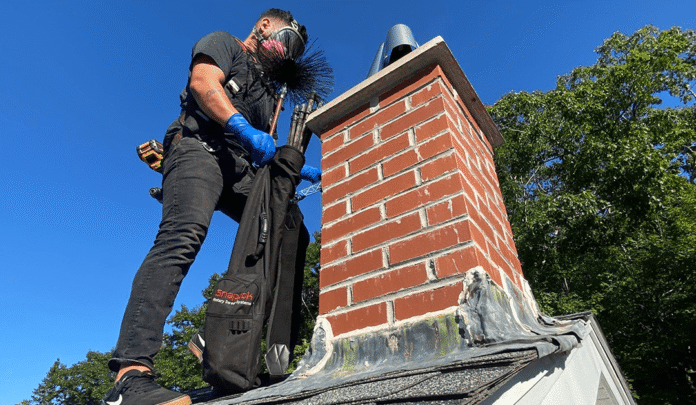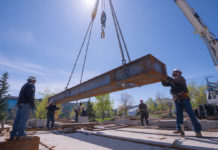As Houston storm season approaches, homeowners are busy prepping their homes for what the Gulf Coast weather is known for, heavy rains, gusty winds, and the occasional hurricane. While people often remember to check their roof shingles, clean their gutters, and trim overhanging branches, there’s one key part of the home that tends to get overlooked: the chimney.
Yes, that beautiful structure rising above your roofline needs just as much love and care before the skies open up. Failing to prepare your chimney for storm season can result in water damage, structural wear, and costly repairs. So how do you know if your chimney is storm-ready? Let’s walk through everything you need to check, fix, and plan for.
Understanding the Risks Houston Weather Poses to Your Chimney
The mix of wind, rain, humidity, and airborne debris that defines storm season in Houston is a perfect cocktail for chimney problems. Chimneys are constantly exposed to the elements, but during storms, their vulnerabilities are magnified.
If your chimney has even minor cracks or gaps, rainwater can seep in and start causing damage from the inside out. Water erodes mortar joints, rusts dampers and fireboxes, and weakens the interior flue lining. Add high winds to the mix, and a loose chimney cap or damaged flashing can turn into a major leak or safety hazard.
That’s why proactive maintenance isn’t just recommended, it’s essential.
The Importance of a Chimney Inspection Before Storm Season
Start with a thorough inspection. Ideally, this should be done by a certified professional, but if you’re handy and cautious, there are a few things you can visually check yourself. Look for any visible cracks in the bricks or mortar, rust around the damper or cap, discoloration (which can indicate moisture issues), and pieces of masonry on the ground around your chimney base.
Pay attention to unusual smells, especially musty odors, as these often signal moisture problems. Don’t forget to inspect the attic and the area where the chimney passes through your roof for signs of water damage or mold.
If anything seems off, or you just want peace of mind, it’s best to bring in an expert. A proper inspection will catch small problems before they become expensive ones.
Chimney Cap: The First Line of Defense
One of the most important components of a storm-ready chimney is the cap. The cap covers the top of your chimney and protects it from rain, debris, and even small animals that might try to make a home there.
If your chimney cap is missing, loose, or rusting, you’re inviting trouble. A missing cap during storm season can allow gallons of water to enter the flue, damaging both the chimney system and your home’s interior. Make sure the cap is securely fastened, made from rust-resistant materials like stainless steel or copper, and fitted properly.
A properly installed cap not only keeps out water but helps prevent downdrafts that can blow smoke back into your living space. It’s a small feature that makes a big difference.
Waterproofing Your Chimney: A Must in Houston
Even if your chimney looks solid, brick and mortar are porous. Over time, rain can penetrate and slowly deteriorate the structure. This is especially true in humid climates like Houston’s, where moisture lingers longer.
Waterproofing your chimney with a breathable, vapor-permeable sealant can extend its lifespan and save you from hefty repair bills down the road. These sealants repel water while still allowing trapped moisture inside the chimney to escape, which prevents mold and freeze-thaw damage.
The process involves cleaning the chimney exterior thoroughly and applying the sealant with either a brush or sprayer. While some homeowners take this on themselves, it’s usually more effective and longer-lasting when done by a pro.
Flashing: The Leak Stopper You Can’t Ignore
The flashing is the metal strip that seals the joint between your chimney and the roof. If it’s cracked, rusted, or improperly sealed, water will find its way in during heavy rains, and that can lead to water stains on your ceiling, mold growth, or even rotting structural wood.
Check the flashing carefully. It should sit tight against both the chimney and the roof with no gaps. Pay attention to any caulking that’s peeling away, as this is often a sign of age or movement.
If you’re unsure what good flashing looks like, take a look at online tutorials or better yet, have a roofing or chimney specialist evaluate it. The fix might be as simple as resealing the flashing, or it might require replacing a few sections, but either way, addressing it now prevents major headaches later.
Chimney Liners: The Hidden Shield
Chimney liners play a vital role in protecting your home. They guard the chimney walls against the corrosive byproducts of combustion and keep the heat and flames safely contained. Over time, especially with water exposure, these liners can crack, corrode, or even collapse.
An inspection will reveal the state of your liner. If damage is found, replacement or relining is essential for safety and efficiency. Modern liners are often made of stainless steel and are far more resilient than older clay tile versions.
Remember, storm damage doesn’t always happen in one dramatic moment. Small amounts of water over time can silently destroy your liner and cause hidden safety risks.
Post-Storm Checkups: Don’t Skip Them
Even if you’ve prepped your chimney perfectly, storms can still take their toll. After every major weather event, take the time to do a visual post-storm check.
Look for any signs of new damage: bricks or debris on the ground, tilting chimney stacks, missing caps, or interior water stains. Also check your fireplace for any rust, odd odors, or soot patterns that seem out of the ordinary.
If you find anything, act quickly. The longer you wait, the more likely small issues will turn into major repairs.
Bonus Tip: Consider Your Entire Ventilation System
Your chimney isn’t the only system in your home that needs to be storm-ready. In fact, homes in Houston often benefit from a holistic approach to ventilation and air flow safety. And yes, that includes your HVAC system. Now’s a good time to also evaluate your ductwork and schedule Air Duct Cleaning if it’s been a while. Cleaner ducts mean better airflow, especially when you’re running your system full blast during muggy post-storm days.
Keep Your Chimney Storm-Ready Year-Round
Preparing your chimney isn’t a one-time event. In Houston’s climate, where the weather can change rapidly and storms are both frequent and intense, chimney maintenance should be part of your seasonal home care checklist.
The key is consistency. Whether it’s inspecting the flashing every spring, waterproofing every few years, or checking the cap after big winds, staying proactive keeps your chimney (and home) protected.
So next time the forecast calls for heavy rain or a tropical disturbance, you can relax a little knowing your chimney is ready for whatever the clouds bring.
Want more tips on protecting your home from Houston’s wild weather? Follow our blog and check back often for updates. We’re constantly adding new info to help homeowners like you stay ahead of the elements.
Check Our Reviews on Google Maps to see what others are saying about our service and dedication. Your peace of mind is just a click away.















